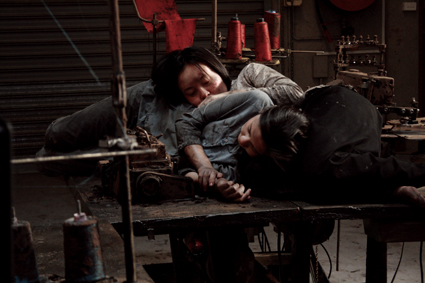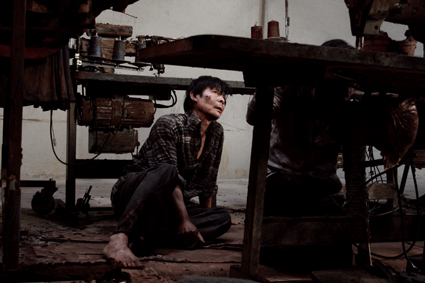boat people: intimate tragedy
caroline wake: khoa do’s mother fish

Mother Fish
KHOA DO’S NEW FEATURE FILM MOTHER FISH BEGINS WITH A BLACK SCREEN, THE SOUND OF RUNNING WATER AND THE OFFICIOUS TONES OF KEVIN RUDD. THE THEN PRIME MINISTER IS ANSWERING MALCOLM FARR, POLITICAL REPORTER FOR THE DAILY TELEGRAPH AND OCCASIONAL COMMENTATOR ON THE ABC TV’S INSIDERS, WHO IS ASKING ABOUT THE “12 BOATS AND 700 PEOPLE” THAT HAVE RECENTLY ARRIVED AT CHRISTMAS ISLAND AND THE POSSIBILITY OF REINTRODUCING MAINLAND DETENTION CENTRES.
The reply is vintage Rudd (“there’s a purpose-built facility there for that purpose”) but it fades into the background as the sound of water grows louder and the camera focuses on a pair of hands washing and chopping vegetables. We hear a voiceover in Vietnamese, spoken in the second-person: “What are you cooking today? You only ever eat greens…You always put too much sugar…I’ll wait for you in the car. Don’t forget to turn the TV off.” The volume on Rudd’s voice increases again and we hear him saying “boats [have] been coming to this country, Malcolm, as you know, since the 1970s.”
From here, we follow the woman (Hien Nguyen) as she drives to work—a small factory with several sewing machines and multiple racks of identical clothing (trendy red checked shirts and long purple skirts). The female voice accompanies her throughout the day and when everyone finally departs in the evening, the woman stays to retrieve a toy monkey that she, or rather the voice, has taken a liking to. The monkey clearly triggers something in her as the present falls away, the past intrudes, and the voice pleads with her to stop.
In an instant the factory transforms into a small boat, with a sewing machine standing in for a motor, a bobbin for a pull cord, and a skirt for a sail of sorts. This rather Brechtian approach, reminiscent of Lars von Trier’s Dogville (2003), is not without its risks but for the most part it works. In this way, Mother Fish effects an unusual reversal: having previously made a rather filmic piece of theatre (RT86) director Khoa Do has now produced a rather theatrical film.
In the absence of actual ocean, the film evokes its presence through camera movement (constantly pitching up and down, as if on a heaving sea) and sound effects (water slopping against the side of the boat, the low drone of the motor). Similarly, the set transforms over the course of the film from a steel-toned workshop—all grey, gold and silver with the occasional shot of red thanks to the bobbins of thread—into a rusted, blasted and scorched shell of itself, barely recognisable under a layer of mud.
On board the “mother fish” are the two sisters Kim (Kathy Nguyen) and Hanh (Sheena Pham), their uncle (Hieu Phan) and a young man Chau (Vico Thai). Sailing out of the harbour, the sisters argue about what they have been allowed to bring and what their mother might have packed for them. However the argument comes to an abrupt end when they hear the sound of a patrol boat and shots being fired. Once out on the ocean, the journey alternates between boredom and terror. During the dull patches they remember the past (dad’s exploits, mum’s food) and rehearse the future (“you’ll never have to cook again because everything comes in a can: chicken in a can; cow in a can; fish in a can”). However these moments are few and far between as the mother fish and her crew endure horror upon horror: first the boat is attacked by pirates, who rape one sister while another watches helplessly; then they are forced to forfeit a precious necklace to bribe an official to tow them into a refugee camp where they are then pushed back out to sea; later Chau jumps ship never to be seen again while Hanh teeters on the brink of death.

Mother Fish
These scenes have the potential to be voyeuristic on the one hand or sentimental on the other, but remarkably they are neither. Instead, this film sails straight and true thanks to the immense restraint of both its actors and director. For their part, the actors play the scenes with absolute control: emotion is evoked through little more than a turn of the head, a glimmer of a tear, or a gentle glance of affection. What little dialogue there is, is spoken with sensitivity and nuance and Thai’s reading of the line “I’m sorry, I’m sorry” hints at his character’s pain and regret as well as compassion. This emotional and verbal reticence is complemented by Do’s visual restraint. For example, when filming the rape scene, gauze drops down over the lens as if to screen it out. Similarly, when characters are at their most vulnerable and distressed often all we see is a cheekbone, a veil of hair or a hunched shoulder.
In the final scenes, we see the younger Kim washing onto the shore and touching the feet of her older self. Once again the camera hovers over the older Kim’s shoulder as we follow her home. She attempts to cook a meal but unable to eat she instead goes for what we think is a walk in the park. However, when the camera finally tilts down it becomes apparent that she has walked into a pond and is plunging into the water. Several silent seconds later (the soundtrack is effectively minimalist), her younger sister and her younger self burst from the water, gasping and reaching for one another. In one of the final images of the film, a small hand reaches for a larger, older one and we hear (once again in Vietnamese), “Sister, is that you?”, to which Hanh replies, “I’m here.”
The film finishes with the astounding statistic that between 1975 and 1996, over 1,500,000 people fled Vietnam. Of those, only 900,000 made land meaning that 600,000 were lost at sea, a catastrophe on a par with 1,700 SIEV Xs. Of the survivors, approximately 137,000 came to Australia. It is now 35 years since this migration started, yet it is only in the past 10 or so years that these stories have started to emerge into the mainstream. Think for instance of exhibitions such as the Casula Powerhouse’s Viet Nam Voices (1997), Viet Nam Voices: Australians and the Viet Nam War (2001-03) and Nam Bang! (2009) [http://realtimearts.net/article/issue90/9390] as well as Nam Le’s book The Boat (2008). Perhaps the first generation was so busy surviving that it is only now, as the second generation makes its mark on the world and starts to have children of their own, that these stories can be told.
Intriguingly, Khoa Do is also planning to tell stories with and about other refugee communities. Mother Fish is the first in a planned “refugee trilogy” with the second film, Falling for Sahara, already in post-production and the third in the early stages of development. Mother Fish suggests the trilogy has the potential to become an Australian film classic.
Mother Fish, writer, producer, director Khoa Do, executive producer Matthew Riley, performers Kathy Nguyen, Sheena Pham, Hieu Phan, Vico Thai, Hien Nguyen; Australia, Titan View
RealTime issue #99 Oct-Nov 2010 pg. 18






